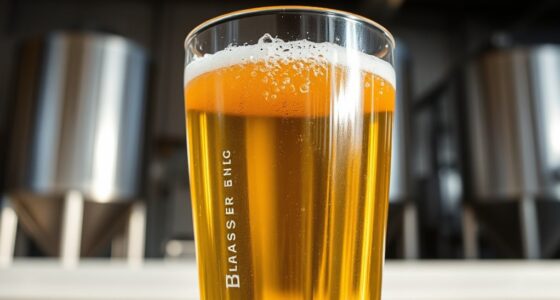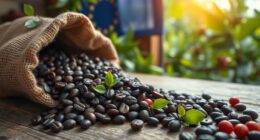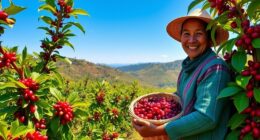Water temperature ramps shape your extraction curve by controlling how flavors and minerals dissolve over time. A steady, gradual increase promotes even extraction and balanced flavors, while rapid ramps can cause uneven development and bitterness. Slower ramps allow for more control, highlighting desired nuances. By managing how quickly or slowly the temperature changes, you influence the overall flavor profile and extraction efficiency. Keep exploring, and you’ll discover how tailoring temperature ramps can elevate your brew.
Key Takeaways
- Water temperature ramps influence the shape and progression of the extraction curve, affecting flavor development over time.
- Gradual temperature increases promote even extraction, leading to a balanced and nuanced flavor profile.
- Rapid temperature ramps can cause uneven extraction, resulting in over-extraction or under-extraction phases.
- Precise control of temperature ramps aligns extraction efficiency with coffee’s solubility curve, optimizing flavor clarity.
- Modulating temperature ramps allows baristas to influence extraction stages, affecting aroma, body, and overall brew quality.
The Basics of Extraction and Temperature’s Role

Understanding extraction is key to controlling the flavor of your brew, and temperature plays a crucial role in this process. When you choose your coffee grind, it influences how quickly or slowly extraction occurs, especially when paired with your brewing equipment. A finer grind increases surface area, which can lead to over-extraction if the water temperature is too high, resulting in bitter flavors. Conversely, a coarser grind may under-extract at lower temperatures, producing weak or sour tastes. The right balance between grind size, brewing equipment, and water temperature ensures ideal extraction. Additionally, the extraction curve illustrates how different temperatures affect flavor development over time. By understanding how these factors interact, you can fine-tune your brewing process to highlight the coffee’s best qualities and avoid undesirable flavors.
Understanding Temperature Ramps in Coffee Brewing
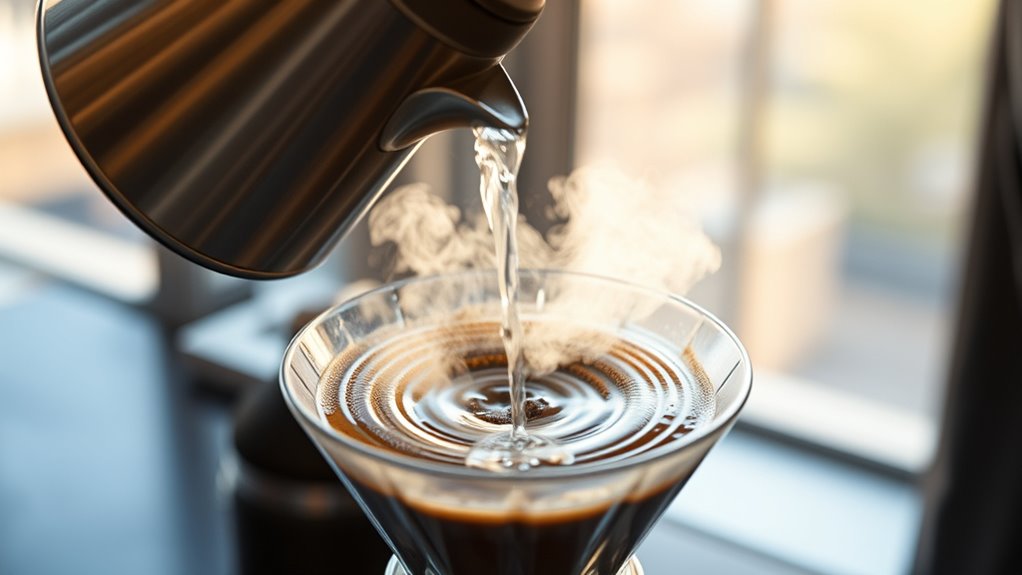
Understanding how temperature changes during brewing can markedly influence your coffee’s extraction. You’ll want to contemplate how different ramp strategies affect the rate at which flavors develop. Exploring ideal temperature ramp techniques helps you achieve consistent and balanced results. For example, carefully managing the temperature ramp can optimize extraction efficiency and enhance flavor clarity.
Temperature Change Dynamics
When you brew coffee, the way temperature changes over time—known as a temperature ramp—plays a crucial role in extracting flavors. This process is influenced by thermal inertia, which determines how quickly the water responds to temperature adjustments. Thermal inertia causes delays in heat transfer, meaning the water’s temperature doesn’t instantly match your set point, creating a gradual change. Understanding these dynamics helps you control how the temperature evolves during brewing, impacting extraction. Faster heat transfer results in sharper temperature ramps, while slower transfer produces gentler curves. Recognizing how thermal inertia affects the temperature change allows you to fine-tune your brewing method for ideal flavor extraction. This knowledge empowers you to manipulate temperature ramps intentionally, shaping the final taste profile. Additionally, equipment setup can significantly influence how these temperature dynamics manifest during brewing.
Impact on Extraction Rate
How does the temperature ramp influence how effectively your coffee extracts flavors? When you control the temperature increase, it directly impacts the extraction rate by maintaining thermal stability during brewing. A steady temperature ramp ensures that heat transfer remains consistent, preventing fluctuations that could cause uneven extraction. This consistency helps maximize the extraction curve, allowing flavors to develop evenly and fully. If the temperature rises too quickly, it may lead to over-extraction early on, while a slow, controlled ramp promotes a balanced extraction process. Ultimately, managing the temperature ramp enhances brew consistency, giving you a more predictable and desirable flavor profile. By understanding this impact, you can fine-tune your brewing method to achieve optimal extraction rates every time. Temperature control is a crucial aspect of producing a high-quality cup of coffee.
Optimal Ramp Strategies
To achieve the best results, you should implement ideal ramp strategies that carefully control how quickly your coffee’s brew temperature increases during brewing. Starting with a lower initial temperature allows for a gradual increase, which enhances extraction efficiency by giving solubles more time to dissolve. A steady, controlled ramp helps prevent under- or over-extraction, ensuring a balanced flavor profile. The goal is to optimize the temperature rise so that it aligns with the coffee’s solubility curve, maximizing extraction without bitterness. Adjusting the rate of temperature increase based on your coffee’s roast level and grind size can further refine the process. Ultimately, precise control of the brew temperature ramp leads to a more consistent, flavorful cup with optimal extraction efficiency. Understanding temperature control is key to mastering the extraction curve in brewing.
How Steady Temperature Profiles Influence Extraction
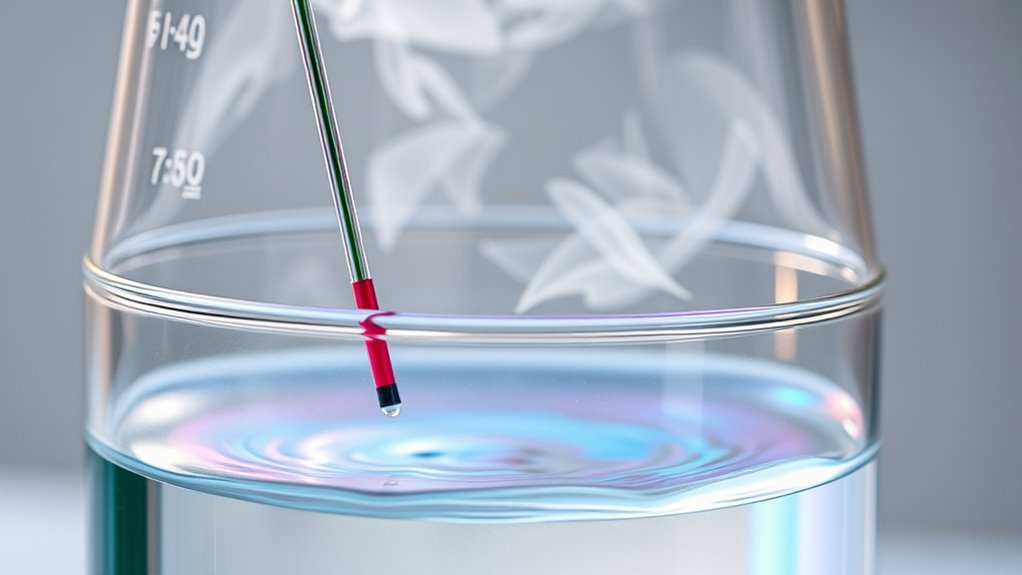
Maintaining a steady temperature helps guarantee your coffee extracts evenly, avoiding under- or over-extraction. When the temperature remains consistent, the brew’s flavors develop predictably, giving you better control. Steady profiles lead to more reliable results with every cup. Additionally, temperature control ensures that the extraction process is optimized for maximum flavor and aroma retention.
Consistent Temperature Benefits
Consistent temperature profiles during brewing play a crucial role in optimizing extraction. When your water temperature remains steady, you promote uniform mineral extraction and better control over water hardness effects. This stability helps prevent uneven extraction, resulting in a more balanced flavor. Maintaining a steady temperature also ensures minerals like calcium and magnesium are released predictably, supporting extraction quality. Additionally, brewing methods that maintain temperature stability can significantly influence caffeine levels and flavor profiles. Here’s a quick overview:
| Temperature Stability | Benefits |
|---|---|
| Consistent heat | Better mineral extraction and water hardness control |
| Uniform extraction | More balanced flavors |
| Predictable results | Reliable brewing outcomes |
Steady Extraction Dynamics
When water temperature stays steady during brewing, it directly influences how efficiently flavors and compounds are extracted from the coffee grounds. Steady temperatures allow heat transfer to occur consistently, minimizing fluctuations that can disrupt extraction. Thermal inertia plays a key role here; by maintaining a stable temperature, the system resists sudden changes, ensuring uniform heat distribution throughout the brew. This consistency helps optimize the extraction of desirable compounds while avoiding over-extraction or under-extraction. As a result, you’ll notice a more balanced and nuanced flavor profile. Temperature stability is crucial for achieving consistent results in brewing. Steady extraction dynamics foster better control over the brewing process, allowing you to focus on other variables. Ultimately, maintaining a stable temperature profile enhances the overall quality and repeatability of your brew.
Impact of Increasing Temperature Ramps on Flavor Development

As temperature ramps increase during water heating processes, they can substantially influence flavor development in the final product. Rapid temperature fluctuation exposes the coffee or tea to higher temperatures more quickly, which can trigger flavor enhancement by releasing volatile compounds more efficiently. These steep ramps accelerate the extraction of certain aromatic oils and solubles, intensifying the overall flavor profile. However, if the temperature rises too quickly, it may cause uneven extraction or burn delicate flavors. The key is balancing the ramp rate to maximize desirable flavor compounds without compromising quality. By carefully controlling the temperature increase, you can fine-tune the flavor development, resulting in a more vibrant and nuanced cup that highlights the specific characteristics of your beans or leaves. Understanding extraction is crucial for optimizing flavor profiles through temperature management.
Effects of Decreasing Temperature Ramps on Brew Characteristics

Lowering temperature ramps during water heating slows the rate at which the temperature increases, allowing for more controlled extraction of flavors. This gradual approach can positively influence water chemistry by minimizing abrupt changes that might extract undesirable compounds. With precise control, you can better target specific flavor profiles and reduce over-extraction, resulting in a cleaner, more balanced brew. Your brewing equipment plays a vital role here; using precise temperature controllers ensures consistent ramps, which can improve overall brew quality. Decreasing temperature ramps also help prevent thermal shocks that might damage sensitive equipment components. By adjusting your water heating process with slower ramps, you gain greater influence over extraction characteristics, leading to more nuanced and refined coffee or tea flavors. Temperature control is essential for achieving optimal brewing outcomes and maintaining equipment longevity.
Comparing Different Ramp Profiles and Their Extraction Curves

Different ramp profiles profoundly influence how extraction unfolds during brewing, shaping the flavor and clarity of the final beverage. A linear ramp offers steady temperature increases, promoting consistent extraction and easier control over brew consistency. In contrast, a rapid or stepwise ramp can cause uneven extraction, potentially highlighting specific flavor notes but risking temperature fluctuations. Maintaining temperature stability across different profiles is essential, as fluctuations can lead to inconsistent results. Comparing these profiles helps you understand how each affects the extraction curve, allowing you to tailor your brewing process for desired flavor profiles. Ultimately, choosing the right ramp profile aligns with your goals for brew consistency and flavor clarity, giving you better control over the final cup.
Practical Techniques for Controlling Temperature Ramps

Controlling temperature ramps effectively requires practical techniques that maintain consistency and optimize extraction. To do this, start by understanding your coffee bean genetics, as different varieties respond uniquely to temperature changes. Adjust your brewing equipment settings to achieve a steady, gradual increase in water temperature, avoiding sudden spikes that can disrupt extraction. Monitoring your water mineral content is vital, too, since minerals influence heat transfer and extraction efficiency. Using a kettle with precise temperature control helps you maintain a consistent ramp rate. Pre-warming your brewing vessel reduces temperature fluctuations. Consistent water mineral content and mindful temperature management allow you to fine-tune your process, ensuring the desired extraction profile and maximizing flavor potential. These techniques help you control the water temperature ramp effectively.
Evaluating the Sensory Outcomes of Various Temperature Strategies

Evaluating the sensory outcomes of various temperature strategies allows you to understand how temperature ramps influence the final flavor profile of your coffee. By tasting and analyzing the results, you can identify which strategies promote better temperature stability and enhance flavor consistency. Consistent temperature control helps prevent uneven extraction, which can cause sourness or bitterness, so observing how different ramps affect taste helps refine your approach. You’ll notice that gradual temperature increases often produce smoother, more balanced flavors, while abrupt changes might introduce unwanted sharpness or variability. Regular sensory evaluation enables you to fine-tune your temperature strategies, ensuring your brewing process consistently delivers the desired aroma, body, and acidity. This hands-on assessment is key to mastering water temperature’s impact on your coffee’s flavor.
Tips for Optimizing Temperature Ramps to Achieve Desired Tastes

Optimizing temperature progressions begins with understanding how gradual or abrupt changes influence your coffee’s flavor development. Thermal conductivity plays a key role in heat transfer between water and coffee grounds, affecting extraction rates and taste. To achieve desired flavors, start with a gentle progression, allowing heat to transfer evenly for balanced extraction. Adjust your temperature increase based on the thermal properties of your brewing method—slower progressions promote clarity, while steeper progressions can intensify body and complexity. Use precise control over your water temperature to fine-tune the extraction curve. Monitoring how heat moves through the coffee helps you craft consistent results and target specific flavor profiles. Experimenting with progression speed and temperature transitions allows you to optimize your brew for the perfect taste.
Frequently Asked Questions
How Do Ambient Conditions Affect Temperature Ramp Consistency?
Ambient conditions, like humidity, can influence your temperature ramp consistency because high humidity levels can cause equipment to respond unpredictably. Maintaining proper equipment calibration ensures your temperature changes stay precise, regardless of ambient humidity fluctuations. To keep your extraction curve steady, monitor humidity levels and regularly calibrate your equipment, so external conditions don’t compromise your brewing process. This attention helps achieve reliable water temperature ramps every time.
Can Temperature Ramps Be Tailored for Specific Coffee Bean Types?
You can tailor temperature ramps for specific coffee bean types, as bean characteristics influence how they respond to heat. Research shows that adjusting temperature profiles impacts roasting outcomes, with delicate beans needing gentler ramps to preserve nuanced flavors. By understanding each bean’s unique roasting impact, you optimize extraction, enhance aroma, and achieve a balanced brew. Experimenting with temperature ramps allows you to uncover the full potential of diverse beans.
What Equipment Best Supports Precise Temperature Ramp Control?
For precise temperature ramp control, you should consider equipment with precision thermostats and digital controllers. These tools let you accurately set and adjust water temperatures throughout the brewing process, ensuring consistent results tailored to your beans. Digital controllers provide fine-tuned adjustments and real-time monitoring, making them ideal for managing specific temperature ramps. Investing in this equipment helps you optimize extraction and achieve the perfect cup every time.
How Do Temperature Ramps Influence Extraction Time?
You’ll notice that adjusting water temperature ramps directly influences extraction dynamics. Faster ramps can reduce extraction time, leading to a more balanced brew, while slower ramps allow for more nuanced flavor development. This control enhances brew stability by preventing over-extraction or under-extraction. By fine-tuning temperature ramps, you optimize extraction time, achieving the desired flavor profile and ensuring consistent results in every cup.
Are There Any Health or Safety Considerations With Temperature Control?
When managing water temperature, you should prioritize water safety and guarantee your equipment calibration is accurate. Proper calibration prevents overheating, which could cause burns or equipment damage. Always check water safety guidelines and maintain your equipment regularly. By doing so, you protect yourself and others from potential hazards and ensure consistent, safe operation during temperature adjustments. Staying vigilant with safety measures helps you avoid accidents and maintain ideal extraction quality.
Conclusion
You might think that controlling water temperature isn’t that crucial, but evidence shows temperature ramps significantly influence extraction and flavor. By experimenting with increasing or decreasing ramps, you can reveal unique taste profiles and optimize your brew. Don’t assume steady temps are always best—try different strategies and see how they impact your cup. The truth is, mastering temperature ramps can elevate your coffee experience, revealing nuances you never knew existed.




